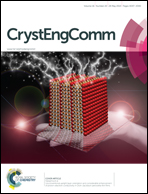Phase-selective hydrothermal synthesis of Cu2ZnSnS4 nanocrystals: the effect of the sulphur precursor†
Abstract
High quality Cu2ZnSnS4 (CZTS) films with uniform thickness and smooth surface were prepared using nanocrystals synthesized by a one-step hydrothermal method. It is found that the nature of the sulphur precursor used in the hydrothermal reaction influences both the compositional purity and the crystal structure of the synthesized hydrothermal product significantly. The CZTS material consisting of both wurtzite and kesterite crystal structures was obtained when using an organic sulfur precursor such as thioacetamide and thiourea in the precursor solution of the hydrothermal reaction while the pure kesterite phase CZTS nanocrystals were made when Na2S was employed as the sulphur precursor. CZTS thin films deposited on a Mo–soda lime glass substrate with uniform thickness (1.7 μm) were made by a simple doctor-blading method. The investigation of the effect of thermal treatment on the film has indicated that the wurtzite CZTS material was completely transformed to the kesterite phase when the material was annealed at 550 °C. Large grains (around 2 μm in size) were found on the surface of the CZTS film which was annealed at 600 °C. The evaluation of the photoresponse of the CZTS thin films has showed that a higher and very stable photocurrent was generated by the film annealed at 600 °C compared to the film annealed at 550 °C.


 Please wait while we load your content...
Please wait while we load your content...